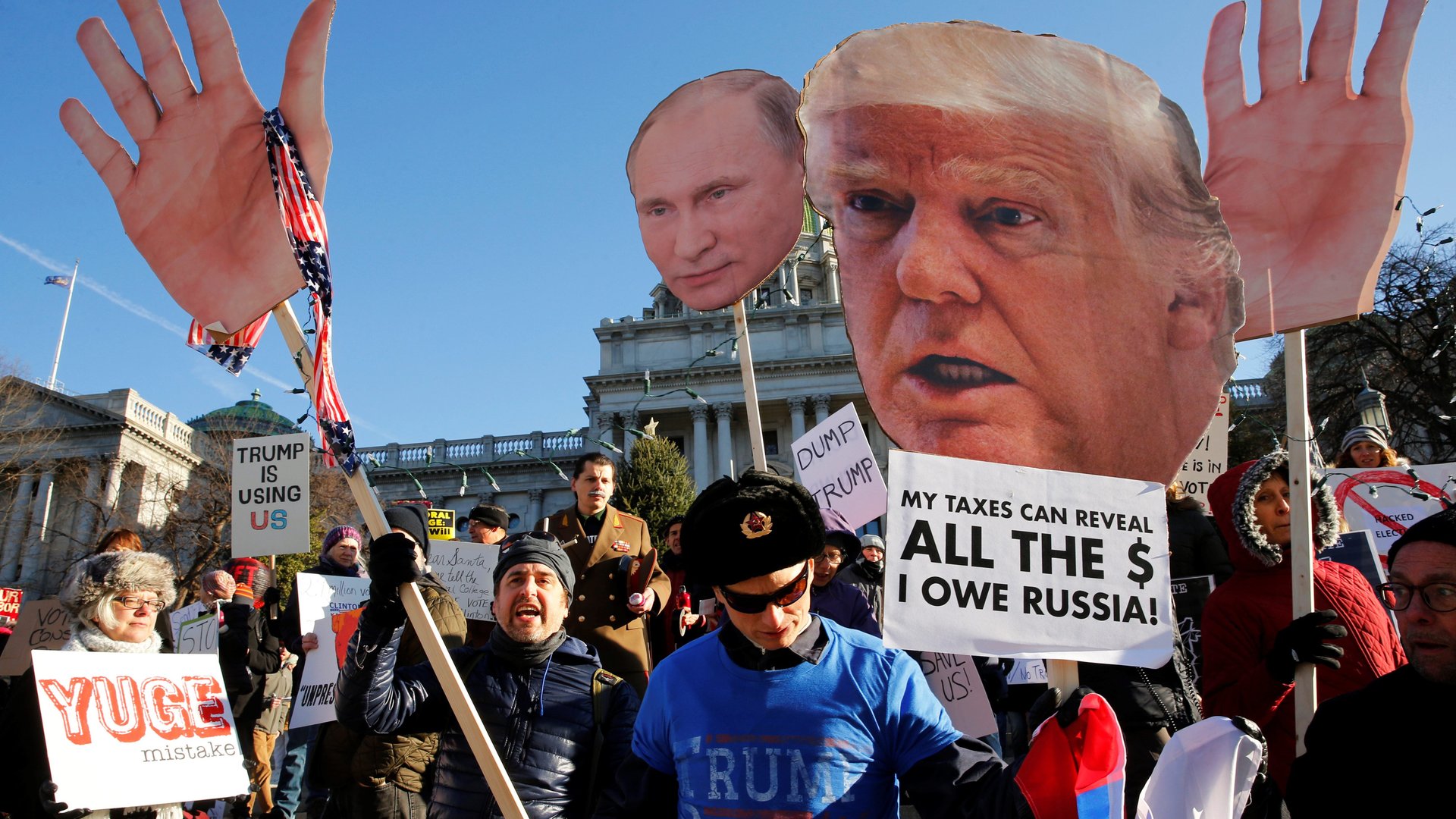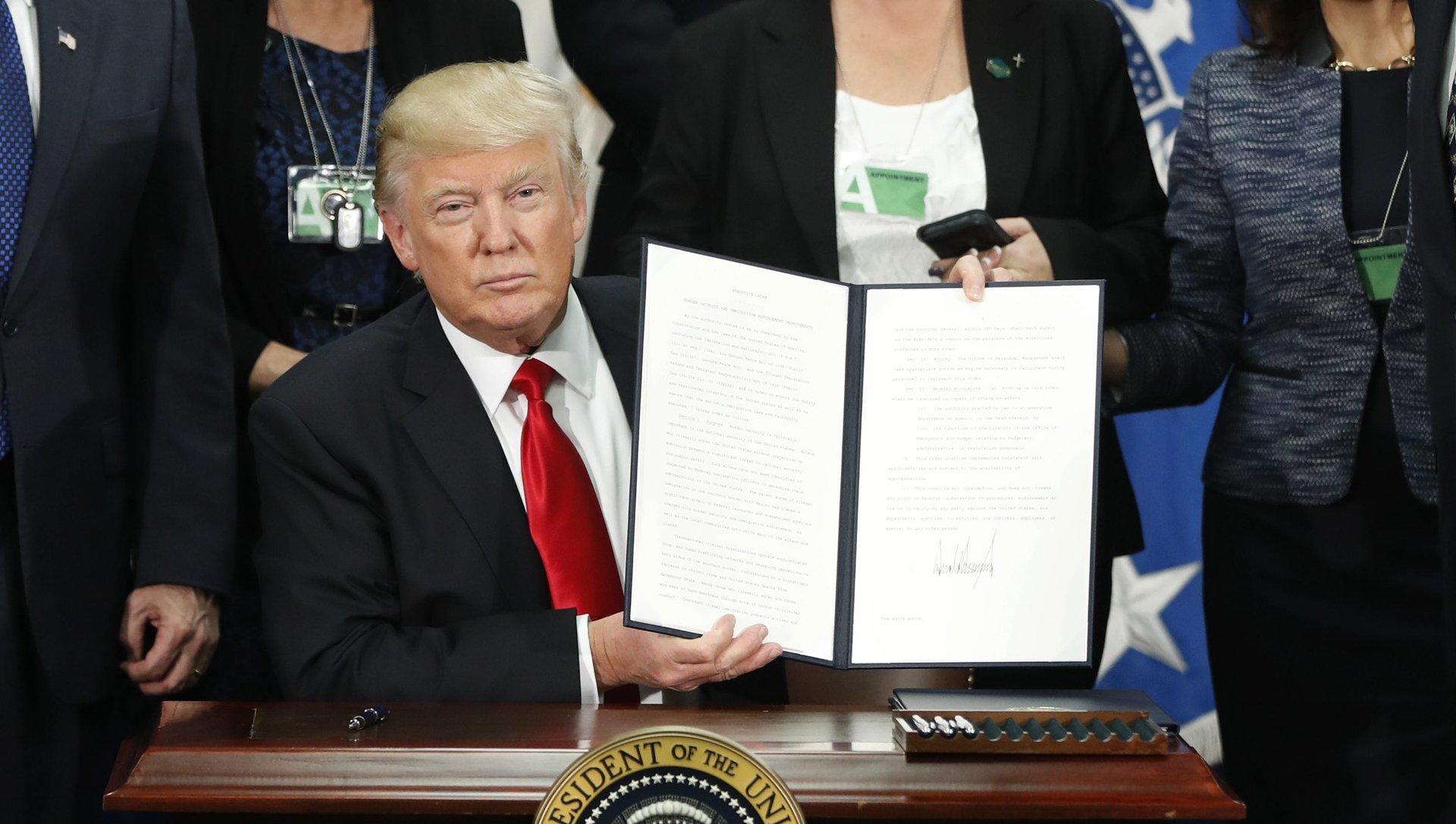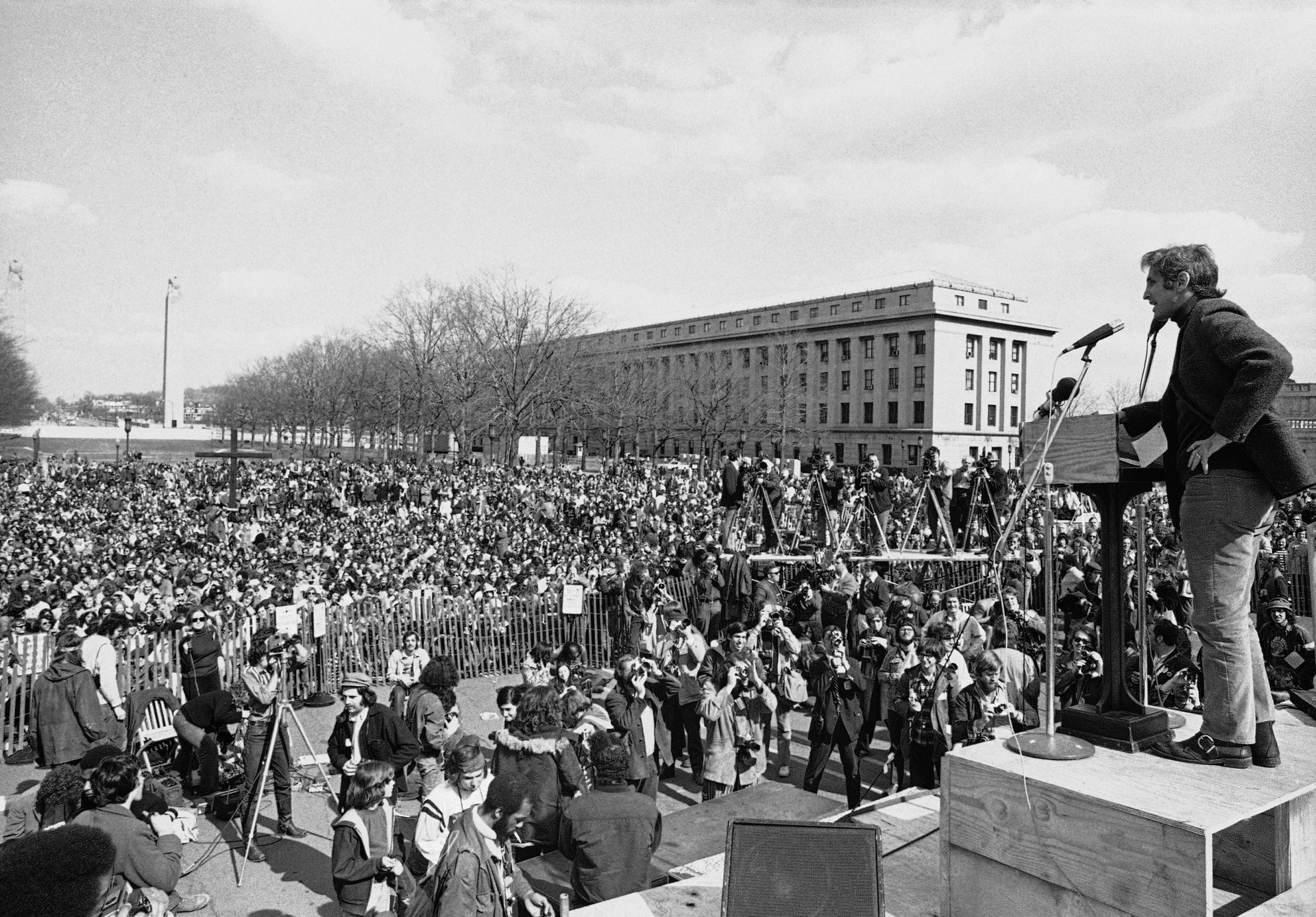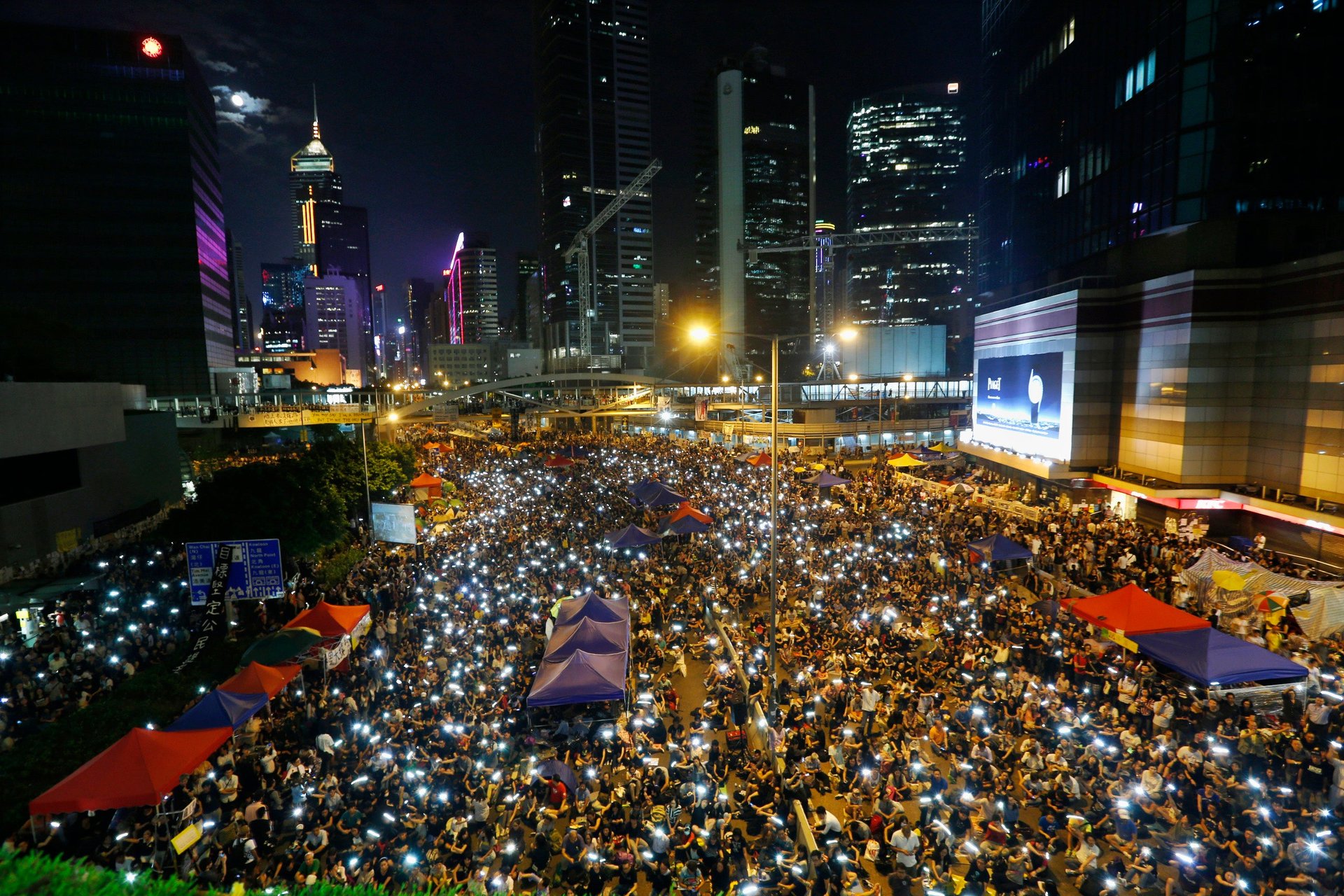Trump’s no compromise presidency sets the stage for a new era of mass protest in America
Compromise is not in the Trump presidency playbook.


Compromise is not in the Trump presidency playbook.
Rather than extending an olive branch to the 73.6% of eligible US voters who did not cast a vote in his favor, or just moving toward the center as many political pundits predicted he would when he took office, new US president Donald Trump has issued a rapid-fire list of executive orders mirroring campaign promises that were viewed as extreme at the time, and is making no concessions to critics.
The Trump administration thinks “that any sign of weakness will create a feeding frenzy,” said Adam Garfinkle, the editor of The American Interest magazine and a former speechwriter for US secretaries of state Colin Powell and Condoleezza Rice. “They know it was a narrow election,” he said. “They know there is Republican opposition.”
Instead of giving an inch, he said, they are betting his critics will back down.
The strategy has been brutally effective, so far, in setting an agenda. But it is already starting to have unintended consequences.
Protests are planned from coast to coast by scientists, environmentalists, and civil rights experts. “The Resistance,” once a darkly humorous hashtag used by left-leaning Twitter, has morphed into something that elected politicians are using as a rallying cry. Given the Trump administration’s early pattern of refusing to concede or compromise, systemic protests across the country could be next.
Trump’s first five days
In Trump’s first week on the job, he has repainted his campaign pledges in bold strokes, and taken further steps that seem designed to antagonize his detractors—the political equivalent of poking your already-defeated opponent in the eye.
Just after his inauguration, he quickly signed an executive order that makes it easier for states to opt out of the Affordable Care Act, despite growing concern among US voters and even Republican politicians about the lack of a replacement health-insurance program. After the Jan. 21 nationwide protest for women’s rights, he cut off funding to nonprofits around the world that even mention abortion, going further than Republicans had in the past. He reopened two controversial pipelines in the US, including one shuttered by the US Army Corps of Engineers for further review and protested by military veterans.
He appalled the intelligence community with a disrespectful speech in front of the CIA’s memorial to men and women who died in the line of service, and incensed scientists by gagging the research arms of government agencies like the US Department of Agriculture and vowing to scrap the country’s landmark programs for climate-change action and waterway regulation.

Then he ordered federal workers to start on plans for building a wall on the US border with Mexico, vowed to strip federal funding from cities that harbor refugees, and promised to publish a list of crimes weekly that are allegedly committed by illegal immigrants. In the remainder of his first week in office, he is expected to ban refugees from the US for several months, temporarily cut off immigration from some Muslim-majority countries, and seek to cut the US role in the UN significantly.
Despite his popularity rating scraping record lows, he seems to be doubling down on his widely panned, factually incorrect beliefs—pledging on Jan. 24, for instance, to start a “task force” to investigate what he suspects was voter fraud in an election he’s already won, even as Republicans like senator Lindsey Graham are begging him to stop making those accusations. “He’s going to look at California and New York,” his press secretary Sean Spicer said on Jan. 25, two states where opponent Hillary Clinton racked up most of the popular votes cast against him.
“This is what America looks like”
The well-planned Women’s March on the day after Trump’s inauguration may be just the beginning. Spontaneous protests against Trump policies have broken out in the US’s biggest cities since he took office, and nationwide ones are being planned.
In response to reports that Trump will shut down immigration for several Muslim-majority led countries, the Council on American-Islamic Relations held an “emergency march” in Manhattan’s Washington Square on the evening of Jan. 25. They were joined by environmentalists protesting the pipeline order, and coalesced into a group estimated at thousands strong, chanting “This is what America looks like.”
San Francisco, Los Angeles, and Boston had smaller events.
As Trump met with Republican leaders in Philadelphia today (Jan. 26) to discuss repealing the Affordable Care Act, a crowd estimated to be a thousand or more gathered outside the Loews Hotel. When President Trump entered the hotel, the crowd booed and shouted “We hate you” and “Go home,” according to the White House press pool report.
The confluence of the civil rights movement, the anti-Vietnam war movement, and the women’s rights movement made the 1960s and 1970s an era of social and political upheaval in America, marked by frequent protests.

But the era of Trump resistance could be more widespread. With the advent of Facebook and Twitter, organizing protests into nationwide “events” has become much easier. The civil rights protest where Martin Luther King delivered his “I have a dream” speech drew 250,000 to Washington DC. The Jan. 21 Women’s March drew more than twice that number in Washington, and an estimated 4 million nationwide.
Over a dozen cities are preparing for the “Trump Tax March,” a protest planned for April 15, the day income taxes are due in the US, calling for Trump to release his tax returns. The protest is attempting to tap into anger about plenty more as well, including economic injustice, with a nod to Trump’s ultra-wealthy cabinet picks.
Scientists also are planning a march, in Washington and across the US, on a date has not yet been set, to “take a stand for science in politics.” Their mantra:
There are certain things that we accept as facts with no alternatives. The Earth is becoming warmer due to human action. The diversity of life arose by evolution. Politicians who devalue expertise risk making decisions that do not reflect reality and must be held accountable. An American government that ignores science to pursue ideological agendas endangers the world.
Meanwhile, there have been plenty of giddy stunts that seem designed to antagonize Trump. A women’s rights group plans to haze his meeting today with Republicans on the ACA health-insurance law by flying a plane overhead with a banner that reads “Fox Poll: ACA More Popular Than Trump.”
According to the Trump administration, the president is governing for all Americans—he ”started on election night bringing the country together,” says Michael Short, a White House spokesman. The current crop of protests is thanks to the “professional left,” he says. “This is what they do.”
Anti-protest measures proposed
Since the US election, a number of Republican lawmakers, perhaps anticipating new points of political friction, have introduced anti-protest bills in several US states (the Intercept has a great rundown of these). For example, a bill in North Dakota, home of the controversial Dakota Access pipeline, would make it legal for motor vehicle operators to run over protesters who are in the street. It says:
Notwithstanding any other provision of law, a driver of a motor vehicle who unintentionally causes injury or death to an individual obstructing vehicular traffic on a public road, street, or highway is not guilty of an offense.
The anti-pipeline protests gained national attention in part after shutting down a nearby highway; the lawmaker who introduced the bill said it was in response to the protests.
In Indiana, a Republican lawmaker proposed a bill that would allow law enforcement to use “any means necessary” to clear roads if as few as 10 protestors were on them. In a hearing on the bill, a Democratic lawmaker warned it could create a “modern day Bull Connor,” referring to the Birmingham, Alabama, commissioner who used dogs and water cannons on civil rights protestors.
What brings ordinary people to the streets
The US’s political apathy is apparent in the miserably low turnout rates in the 2016 election, when 42% of voters stayed home. But Trump’s critics are getting more vocal. And the administration’s refusal to acknowledge their concerns, or to heed the message that protestors are trying to send, shares some similarities with the Chinese Communist Party in the weeks before the protests that shut down the center of Hong Kong for months in 2014.
Both cases involve a government and a leader that, on paper, are supposed to represent all citizens and their rights—but refuse to hear any opposition. In Hong Kong’s case, citizens who were promised “universal suffrage” to choose a city leader came out to protest when Beijing insisted on pre-vetting any candidates. While the protests started with a relatively small group of students, even normally apolitical citizens, of all generations, came into the streets after police attacked protestors with tear gas.

The aftermath of the Hong Kong protests has brought something that would have been unthinkable just a few years ago. When Beijing characteristically refused to budge on allowing citizens to choose candidates for the city’s leadership, this sparked the creation of a new political movement—one calling for the city to be fully independent from China.
What happens next in America hinges on whether the various groups opposing Trump become a cohesive bloc.
In the coming months, “there will be lots of demonstrations, and there could be systemic protests,” Garfinkle says. But unless they become mainstream enough to address issues like jobs and changing communities, these protests “won’t create a political salient movement with a resonance to most Americans that’s going to bother the administration,” he adds.
Meanwhile, when Trump stands up to demonstrators, that “deepens the affection his followers have” for him, Garfinkle says. While they’re only a minority, that’s “all that you need” to get power, he notes. The question now is how effectively Trump can use that power without the support of a majority of Americans.